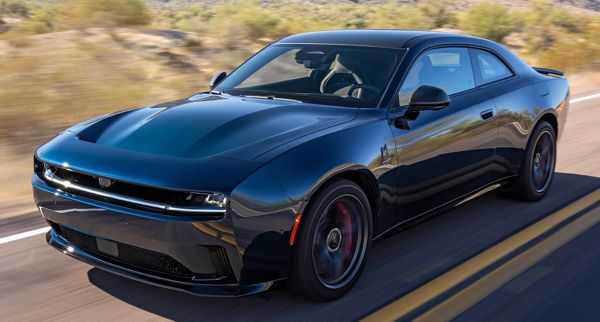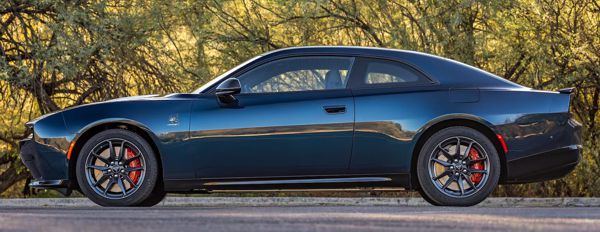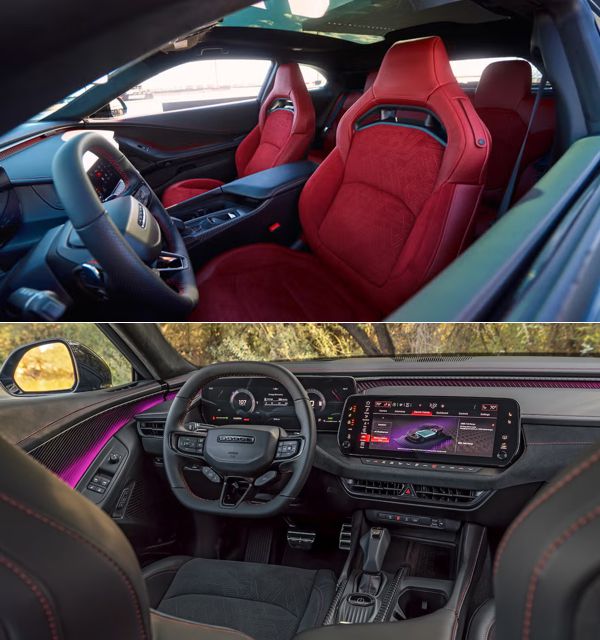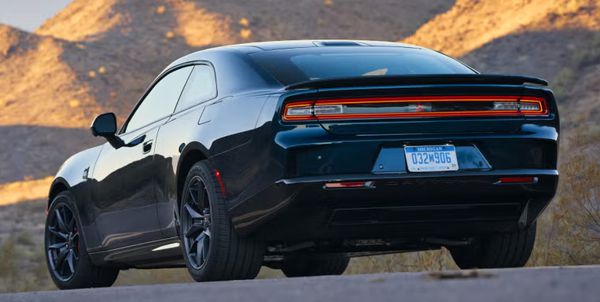Published
on 14
Feb 2025
|
All rights reserved.
|
|
|

|
|
Electric
muscle car both surprises and disappoints...
|
|
If
muscle cars are nonsense, an electric muscle car sounds even more
ridiculous. Somehow, I do love the concept of Dodge Charger Daytona
very much. Think about it: as quick as some EVs go, they all look
boring and similar to each other. Too much efficiency-oriented, too
much shaped by aerodynamics and too much lack of emotions. Dodge
Charger Daytona is not the same. You won’t expect an EV could look so
much like a modern evolution of the 1968 Charger – even though it
doesn’t look like the original Daytona at all. It is huge. It looks
bold and brutal. It has that kind of magic that raises your pulse and
blood pressure even before pressing the start button.
Yes, it is really huge, bringing you back to the good old days. 5.25
meters long, over 2 meters wide and 1.5 meter tall, a 3075mm wheelbase
and a kerb weight of 2.6 tons… and yet this is just a 2-door coupe!
Dodge will build a 4-door version to broaden its customer appeal, but
that is another topic. There will be ICE version coming later this
year, too, which employs the Hurricane 3.0-liter twin-turbo
straight-six that is already serving some Jeep SUVs and Ram trucks and
offer up to 550 hp. They will be called “Sixpack” instead of “Daytona”,
but that is another story. In short, the Stellantis group STLA Large
platform on which it is built is quite versatile.
Given so much length and width to work with, its designers managed to
provide a spacious cabin without compromising the coupe’s look.
Coke-bottle flowing waistline resembles the original Charger, ditto the
full-width intake at the nose that is cleverly used as a Ferrari-style
S-duct to generate downforce, as the EV does not need much cooling.
Overall, it is a sleek design that hits the sweet spot between modern
and retro, much better than the outgoing Challenger did.

|
|
A
sleek design that hits the sweet spot between modern and retro.
|
|
Inside, you
will find the most spacious cabin this side of a Rolls-Royce Spectre.
The rear bench is truly for adults, as a 6-footer can sit behind
another 6-footer with room to spare. Compared with a BMW 4-Series Coupe
– its closest if unlikely cross-shopping rival – the Daytona’s rear
seat offers 43mm more headroom and 69mm more legroom as well as
significantly more shoulder room. It is also a lot roomier than its
predecessor Challenger, if not quite as spacious as the outgoing
Charger saloon. The trunk is huge at 646 liters and can be expanded
further with rear seats folded. If still not enough, there is a small
frunk up front. And yes, this is a hatchback, so putting big items into
the boot is easy.
The front seats are wide and comfortable if not that hugging. They are
mounted higher than normal, inevitably, but in return you have good
visibility all-round. The wide and low-set dashboard looks good and
suitably trimmed to feel much more expensive than its predecessors.
There are more physical buttons than BMW for straightforward access,
while Chrysler’s Uconnect 5 infotainment system is easy to operate. The
12.3-inch touchscreen is responsive, while digital instrument display
(10.3-in or 16.0-inch depending on model) looks crisped and is
configurable. Ambient lighting in dash and doors add to a premium feel,
as do the optional panoramic glass roof and head-up display. This car
is a night and day difference from the old LX platform cars.
All Daytona models employ the same electrical hardware including a
100.5 kWh (gross) underfloor battery and twin-motor all-wheel drive
setup. The front motor can be disconnected to save energy, while the
rear axle includes a standard mechanical LSD. Each power module is the
same, comprising of a 335 hp motor, its own step-down gearset and
inverter. In theory, maximum output should be 670 hp. However, Dodge
deliberately restricts the output to create different models. Base
model called R/T offers 496 hp and 404 lbft of torque, which includes a
40 hp overboost for 15 seconds by pressing the “Powershot” button on
steering wheel. 0-60 mph is quoted at 4.7 seconds while top speed is
limited to 137 mph. 317 miles EPA range is pretty useful, but the
asking price of $62,000 is probably too much for this kind of
performance, even though the Daytona is a lot of car for the money.
 |
|
The
most spacious cabin this side of a Rolls-Royce Spectre...
|
|
Pay an extra $13,000 will get Scat Pack model, unlocking the full 670
ponies and 627 pound-foot of torque, cutting 0-60 to merely 3.3 seconds
although top speed drops back to 134 mph, curiously. It is slightly
more expensive than a BMW M440i xDrive Coupe or Hyundai Ioniq 5 N, but
considering the performance, drama and space it offers, it is actually
quite competitive. The Scat Pack’s powertrain is just the same as R/T,
but its chassis gets larger wheels and brakes, massive tires and
dual-valve adaptive dampers to support the enhanced performance.
Moreover, it gets Track mode, Drift mode and even Donut mode to play
with. On the downside, mileage drops to 241 miles with all-season
tires or 216 miles with summer tires fitted. Yes, muscle cars are never
frugal, no matter ICE or electric-powered.
Both models run at 400V electrical architecture thus charging speed is
pretty slow, peaking at only 183 kW. That’s why the upcoming Banshee
model – supposedly the equivalent of Hellcat – will bring 800V battery
and faster charging along with far more power and 2-speed transmission.
On the Road
Forget the slower R/T, let’s concentrate on the 670hp Scat Pack. Right
from pressing the start button you’ll hear a V8 roars into life from
the back. That’s the function of “Fratzonic Chambered Exhaust”, an
artificial sound system that uses not only the cabin’s audio speakers
but also a 600W subwoofer mounted under the trunk to generate fake
exhaust note, mostly resembling a Hemi V8. I like this idea, as it
gives the aural excitement EVs desperately needed, but the execution of
Stellantis’ acoustic engineers is far from perfect. Sure, the noise is
loud, and it changes from startup to idling to running across the rev
range, but each stage appears abruptly as if sticking two very
different sound profiles together, making it sounds fake. The idea is
good, the hardware is right there, but all Dodge needs to do is the
software side, hire better people from the sound/music industry to fine
tune the sound profiles. As it is, the Fratzonic thing gets mostly
negative comments from reviewers. Instead of abandoning it, I hope
Dodge will keep working on it, because the potential is right there.
Over the air update would be great.

|
|
The
idea of Fratzonic exhaust is good, the hardware is right there, but all
Dodge needs to do is the software side... |
|
In normal
driving, the Daytona feels good. Yes, it is heavy, but there is more
than enough instant grunt to overcome its mass and propel the car to
whatever speed you feel comfortable with on public roads. Maybe not as
quick as its 3.3 seconds 0-60 mph time suggested, but still respectably
fast for such a big coupe. Moreover, the way it accelerates or cruises
doesn’t feel like a muscle car at all. On the contrary, it is
remarkably refined, being quiet (if you turn off the fake exhaust) and
smooth. The car feels solid, thanks to a chassis rigidity 50 percent
higher than its predecessor. Wind noise is well insulated from the
cabin. The all-round multi-link suspension with dual-valve adaptive
dampers does a good job to offer a smooth ride, a night and day
difference from the old car. The Daytona is surprisingly civilized, or
even with some hint of luxurious motoring.
Push harder and the immense weight starts affecting its dynamics. It is
still far more stable and accurate than either the old Charger or
Challenger, as the center of gravity is lower and weight distribution
approaches 50:50 (actually 48:52). There is less understeer for sure,
and body control
is better. This allows it to use more of the traction and grip
generated by massive Goodyear Eager F1 tires. The car steers more
willingly, although the steering is a tad light and remote. The brakes
have adequate stopping power, but pedal suffers from a non-linear
response typical to many EVs. Ultimately, with so much mass to take
care of, the car will understeer. You might expect Drift mode could
bring some fun in corner, but in reality it is very hard to sustain,
because the rear motor is no more powerful than the front. All the
computer can do is to turn off the front motor, leaving only 335 hp to
propel a 2.6-ton car, so you can imagine not quite a drift machine.
Let’s hope the Banshee flagship will use a bigger rear motor.
At this price level, the Charger Daytona no longer offers class-leading
bang for the buck. Hyundai Ioniq 5N is just as quick, far more capable
in corners and offers way more fun from its simulated power band and
gearchange, though few people would cross-shop a large muscle car with
a family hatch, especially when it looks so good. BMW M440i xDrive
Coupe (or Gran Coupe) is simply too small and too ordinary. Ford
Mustang is 2+2, while Mustang Mach-E is an SUV-crossover without any
muscle car flavours. The Daytona has no direct rivals on the market,
but succeed or not will depend on whether the existing buyers of muscle
cars are convinced that it is a good replacement for Hemi V8, not just
the fake noise.
|
Verdict:     |
|